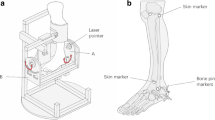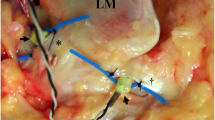Abstract
Purpose
Peroneal tendons are known as active stabilizer in acute ankle sprain while an intact ankle mortise and intact lateral ligaments are required for passive stability of the ankle joint. The goal of this study is to determine the peroneal tendons as passive stabilizer in case of lateral ligament instability.
Methods
Twelve (12) human lower leg cadaver specimens underwent a torsion simulation in the testing system, 858 Mini Bionix® (MTS® Systems Corporation, Eden Prairie, MN, USA) and a specially designed mounting platform for the specimens. The preset torsion between tibia and calcaneus was primarily set at 30° of internal rotation during plantar flexion and hindfoot inversion. The resisting torque around mechanical tibial axis was recorded which ensures stability in ankle sprain trauma. The first series of measurements were performed on healthy specimens and the following after transecting structures in following order: ATFL (anterior talofibular ligament) in combination with CFL (calcaneofibular ligament), followed by peroneus longus tendon and finally peroneus brevis tendon.
Results
The combined lateral ATFL and CFL instability shows a decrease of the resisting torque which ensures stability in ankle sprain trauma. Only a transection of PLT with existing lateral dual-ligament instability results in a significant decrease in torque (p < 0.0001).
Conclusion
The PLT has a substantial effect on passive stability at a present lateral ligament lesion in ankle sprain trauma. A deficiency in viscoelastic properties of the peroneus longus tendon must be considered in diagnostic and treatment for ankle instability.




Similar content being viewed by others
References
Bare A, Ferkel RD (2009) Peroneal tendon tears: associated arthroscopic findings and results after repair. Arthrosc J Arthrosc Relat Surg Off Publ Arthrosc Assoc N Am Int Arthrosc Assoc 25(11):1288–1297
Beumer A, Valstar ER, Garling EH, Niesing R, Ginai AZ, Ranstam J, Swierstra BA (2006) Effects of ligament sectioning on the kinematics of the distal tibiofibular syndesmosis: a radiostereometric study of 10 cadaveric specimens based on presumed trauma mechanisms with suggestions for treatment. Acta Orthop 77(3):531–540
Ebig M, Lephart SM, Burdett RG, Miller MC, Pincivero DM (1997) The effect of sudden inversion stress on EMG activity of the peroneal and tibialis anterior muscles in the chronically unstable ankle. J Orthop Sports Phys Ther 26(2):73–77
Fujii T, Kitaoka HB, Luo ZP, Kura H, An KN (2005) Analysis of ankle-hindfoot stability in multiple planes: an in vitro study. Foot Ankle Int 26(8):633–637
Garrick JG (1977) The frequency of injury, mechanism of injury, and epidemiology of ankle sprains. Am J Sports Med 5(6):241–242
Geppert MJ, Sobel M, Bohne WH (1993) Lateral ankle instability as a cause of superior peroneal retinacular laxity: an anatomic and biomechanical study of cadaveric feet. Foot Ankle 14(6):330–334
Gollhofer A, Alt W, Lohrer H (2000) Prevention of excessive forces with braces and orthotics. Handbook of sports science, Champaign
Heckman DS, Gluck GS, Parekh SG (2009) Tendon disorders of the foot and ankle, part 1: peroneal tendon disorders. Am J Sports Med 37(3):614–625
Konradsen L, Ravn JB (1990) Ankle instability caused by prolonged peroneal reaction time. Acta Orthopaedica 61(5):388–390
Konradsen L, Ravn JB, Sorensen AI (1993) Proprioception at the ankle: the effect of anaesthetic blockade of ligament receptors. J Bone Joint Surg Br 75(3):433–436
Konradsen L, Voigt M, Hojsgaard C (1997) Ankle inversion injuries. Am J Sports Med 25(1):54–58
Lee AJ, Lin WH (2008) Twelve-week biomechanical ankle platform system training on postural stability and ankle proprioception in subjects with unilateral functional ankle instability. Clin Biomech (Bristol, Avon) 23(8):1065–1072
Löfvenberg R, Kärrholm J, Sundelin G, Ahlgren O (1995) Prolonged reaction time in patients with chronic lateral instability of the ankle. Am J Sports Med 23(4):414–417
Lorenzetti F, Lazzeri D, Bonini L, Giannotti G, Piolanti N, Lisanti M, Pantaloni M (2010) Distally based peroneus brevis muscle flap in reconstructive surgery of the lower leg: postoperative ankle function and stability evaluation. J Plast Reconstr Aesthet Surg 63(9):1523–1533
McCullough CJ, Burge PD (1980) Rotatory stability of the load-bearing ankle. An experimental study. J Bone Joint Surg Br 62-B(4):460–464
Munn J, Sullivan SJ, Schneiders AG (2010) Evidence of sensorimotor deficits in functional ankle instability: a systematic review with meta-analysis. J Sci Med Sport/Sports Med Aust 13(1):2–12
Philbin TM, Landis GS, Smith B (2009) Peroneal tendon injuries. J Am Acad Orthop Surg 17(5):306–317
Rahnama L, Salavati M, Akhbari B, Mazaheri M (2010) Attentional demands and postural control in athletes with and without functional ankle instability. J Orthop Sports Phys Ther 40(3):180–187
Sobel M, Geppert MJ, Olson EJ, Bohne WH, Arnoczky SP (1992) The dynamics of peroneus brevis tendon splits: a proposed mechanism, technique of diagnosis, and classification of injury. Foot Ankle 13(7):413–422
Thornton GM, Shrive NG, Frank CB (2001) Altering ligament water content affects ligament pre-stress and creep behavior. J Orthop Res 19(5):845–851
Walther M, Morrison R, Mayer B (2009) Retromalleolar groove impaction for the treatment of unstable peroneal tendons. Am J Sports Med 37(1):191–194
Wapner KL, Taras JS, Lin SS, Chao W (2006) Staged reconstruction for chronic rupture of both peroneal tendons using Hunter rod and flexor hallucis longus tendon transfer: a long-term followup study. Foot Ankle Int 27(8):591–597
Weindel S, Schmidt R, Rammelt S, Claes L, von Campe A, Rein S (2010) Subtalar instability: a biomechanical cadaver study. Arch Orthop Trauma Surg 130(3):313–319
Ziai P, Sabeti-Aschraf M, Fehske K, Dlaska C, Funovics P, Wenzel F, Graf A, Buchhorn T (2011) Treatment of peroneal tendon dislocation and coexisting medial and lateral ligamentous laxity in the ankle joint. Knee Surg Sports Traumatol Arthrosc 19(6):1004–1008
Acknowledgments
The authors would like to thank Constantin E. Dlaska from the Department of Trauma Surgery, Medical University of Vienna.
Conflict of interest
The authors declare that they have no conflict of interest.
Author information
Authors and Affiliations
Corresponding author
Rights and permissions
About this article
Cite this article
Ziai, P., Benca, E., von Skrbensky, G. et al. The role of the peroneal tendons in passive stabilisation of the ankle joint: an in vitro study. Knee Surg Sports Traumatol Arthrosc 21, 1404–1408 (2013). https://doi.org/10.1007/s00167-012-2273-2
Received:
Accepted:
Published:
Issue Date:
DOI: https://doi.org/10.1007/s00167-012-2273-2




